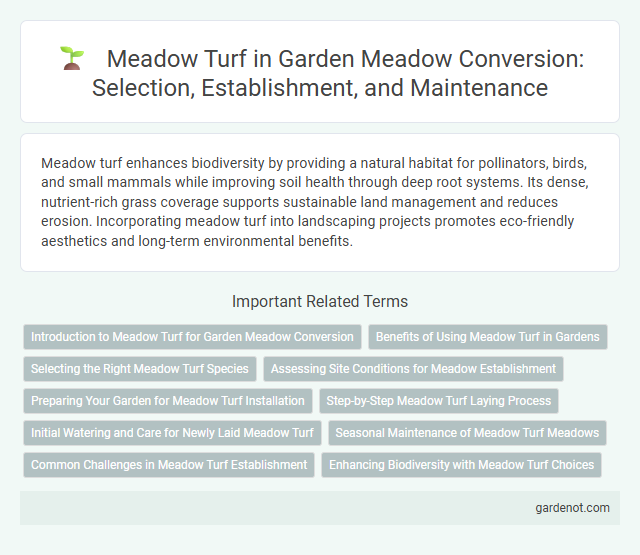Meadow turf enhances biodiversity by providing a natural habitat for pollinators, birds, and small mammals while improving soil health through deep root systems. Its dense, nutrient-rich grass coverage supports sustainable land management and reduces erosion. Incorporating meadow turf into landscaping projects promotes eco-friendly aesthetics and long-term environmental benefits.
Introduction to Meadow Turf for Garden Meadow Conversion
Meadow turf offers an effective solution for garden meadow conversion by providing an instantly established layer of native meadow plants and grasses, promoting biodiversity and ecological balance. Its pre-grown composition accelerates habitat development, reduces soil erosion, and supports pollinators such as bees and butterflies. Using meadow turf enhances soil health through natural root structures while creating a sustainable, low-maintenance garden landscape.
Benefits of Using Meadow Turf in Gardens
Meadow turf enhances garden biodiversity by providing a habitat for pollinators and beneficial insects, supporting local ecosystems. Its low-maintenance nature reduces the need for frequent mowing, watering, and chemical treatments, promoting sustainable gardening practices. Furthermore, meadow turf improves soil health and water retention, creating a resilient and environmentally friendly lawn alternative.
Selecting the Right Meadow Turf Species
Selecting the right meadow turf species depends on soil type, climate, and intended use to ensure optimal growth and sustainability. Native species like wildflowers, grasses such as fescues, and legumes promote biodiversity while requiring minimal maintenance. Accurate species selection enhances ecological benefits, supports pollinators, and creates resilient meadow ecosystems tailored to local environmental conditions.
Assessing Site Conditions for Meadow Establishment
Assessing site conditions for meadow establishment involves evaluating soil type, drainage, sunlight exposure, and existing vegetation to ensure optimal growth of meadow turf. Soil pH and fertility tests determine nutrient availability, influencing seed selection and recommended soil amendments. Understanding microclimate factors and topography aids in predicting water retention and plant stress, critical for successful meadow turf conversion.
Preparing Your Garden for Meadow Turf Installation
Preparing your garden for meadow turf installation requires thorough soil preparation to ensure healthy root establishment and optimal growth. Begin by clearing debris, weeds, and existing grass, then loosen the soil to improve aeration and drainage, aiming for a depth of at least 15 cm. Incorporate organic matter or compost to enrich the soil, creating a fertile environment that supports meadow turf's diverse wildflower and grass species.
Step-by-Step Meadow Turf Laying Process
Meadow turf laying begins with site preparation, including soil cultivation and leveling to ensure optimal root penetration and water drainage. Next, turf rolls are unrolled tightly in staggered rows while maintaining consistent soil contact to prevent air pockets and promote healthy turf establishment. Finally, the newly laid meadow turf is watered deeply and monitored regularly for moisture retention and early signs of stress during the initial growth phase.
Initial Watering and Care for Newly Laid Meadow Turf
Newly laid meadow turf requires immediate and thorough initial watering to ensure soil saturation and promote root establishment. Consistent moisture levels must be maintained during the first two weeks to prevent drying out, which can severely impact turf health and growth. Proper care includes avoiding foot traffic and mowing until the turf roots have firmly anchored into the soil, typically after 3 to 4 weeks.
Seasonal Maintenance of Meadow Turf Meadows
Seasonal maintenance of meadow turf meadows involves mowing once or twice annually to promote biodiversity and prevent woody plant encroachment. Fertilization is minimal or avoided to maintain nutrient-poor soil conditions essential for native wildflowers and grasses. Regular monitoring for invasive species and selective removal ensures the long-term health and ecological balance of the meadow ecosystem.
Common Challenges in Meadow Turf Establishment
Common challenges in meadow turf establishment include poor seed germination due to inadequate soil preparation and inconsistent moisture levels. Weed competition often arises, hindering young meadow plants from thriving and reducing biodiversity. Pest infestations and fluctuating weather conditions further complicate successful meadow turf development.
Enhancing Biodiversity with Meadow Turf Choices
Meadow turf selections play a crucial role in enhancing biodiversity by providing diverse habitats for pollinators, insects, and small wildlife. Choosing native wildflower blends and grasses tailored to local soil and climate conditions supports ecological balance and increases species richness. Sustainable meadow turf conversion fosters resilient ecosystems that improve soil health and promote long-term environmental benefits.
Meadow turf Infographic

 gardenot.com
gardenot.com